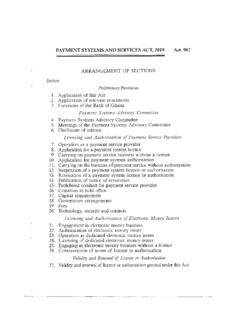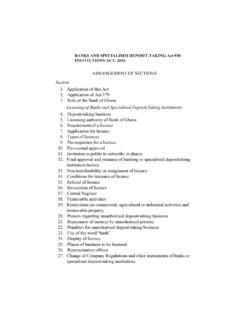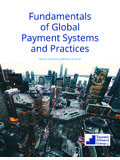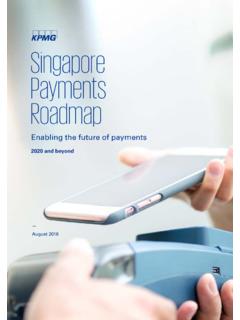Transcription of BANK OF GHANA
1 1 bank OF GHANA NOTICE TO BANKS AND SAVINGS AND LOANS COMPANIES NOTICE NO. BG/GOV/SEC/2008/21 GUIDELINES FOR BRANCHLESS BANKING Branchless Banking (BB) represents a significantly cheaper alternative to conventional branch-based banking that allows financial institutions and other commercial actors to offer financial services outside traditional bank premises by using delivery channels like retail agents, mobile phones etc. BB can be used to substantially increase the financial services outreach to the un-banked communities.
2 These guidelines are being issued as part of the broader strategy to create an enabling regulatory environment to promote branchless banking. The primary audience of these guidelines is deposit-taking financial institutions ( bank and non- bank ) desirous to undertake branchless banking. However, as financial institutions cannot take on BB without the help of other market players like telecom companies, technology service providers, agents etc., these guidelines are also helpful for other parties to understand their roles and responsibilities.
3 Objectives The guidelines for branchless banking set out by the bank of GHANA are aimed at achieving a number of objectives: Promoting financial inclusion without risking the safety and soundness of the banking system. Extending core banking services to the domain of everyday transactions. Ensuring that the common platform for the payments and settlement system (e-zwich) established for deposit taking financial institutions (FIs) extends to branchless banking. Ensure that banking services provided under branchless banking are provided by regulated deposit-taking financial institutions or their agents.
4 Ensure compliance with GHANA s Anti-Money Laundering Act as well as the Anti-Money Laundering and Financing of Terrorism (AML/CFT) standards as set by the Financial Action Task Force (FATF). 2 Ensure a wide participation of deposit-taking financial institutions ( banks and non-banks) including commercial banks, rural banks, savings and loans and microfinance institutions in the provision of branchless banking services. Ensure that all branchless banking transactions are cleared through the settlement system. Ensure that all customers using branchless banking services can be uniquely identified.
5 Scope These guidelines are applicable to deposit-taking financial institutions (herein after collectively referred to as financial institutions or FIs). Activities outlined in these guidelines as branchless banking cannot be offered by any person or institution other than deposit-taking financial institutions (FIs). All FIs desirous to offer branchless banking services may do so in line with these guidelines. These guidelines do not, in general supersede or revoke any of the existing Laws, rules & regulations unless specifically stated.
6 Further the scope of any such relaxation of rules and regulations will be limited to Branchless banking only and shall not extend to cover any other banking activity Branchless Banking Models and Activities Branchless banking is only allowed to be undertaken by licensed deposit-taking financial institutions ( bank and non- bank ) or their agents. Furthermore, all customers of FIs undertaking BB activities must be uniquely identified. Branchless banking can be done using agents like Telcos, Fuel distribution companies, Merchants, Post Office, etc.
7 And using technologies not limited to mobile phone (like GPRS, POS terminals etc.). In each case customer account relationship must reside with some FI and each transaction must hit the actual customer account. Model For GHANA As stated above, only the FI-led model of branchless banking is allowed and may be implemented in different ways. Firstly, it can be implemented either by using agency arrangements or by creating a partnership between a FI and Agent company ( Telco) 3 Further, while mobile phone banking which makes up for large part of branchless banking can be implemented by using a number of models1, to ensure maximum connectivity and outreach as well as interoperability, the Many-to-Many Model is the only permissible model in GHANA .
8 Exclusive partnerships are not allowed. This model offers the maximum connectivity and hence maximum outreach and is closer to the desired situation where all FIs and all telcos should be able to entertain each other s customers (Just like the existing ATM network being developed in the country where customer of any bank will be able to use ATM of any other bank ). Under this model, FIs and Telecom operators are expected to join hands to offer mobile banking services to the public with central processing of transactions through the GHANA Interbank Payment and Settlement System (GhIPSS) which will: i) settle all transactions on real time basis or through a regulated clearing arrangement, ii) store all proofs of transactions and iii) provide a day end reconciliation to all member FIs.
9 In this regard, all new switches, ATMS, Points of Sale (POS), card or mobile phone payments products issued or deployed by banks and deposit taking financial institutions must be e-zwich compliant or interfaced with the e-zwich platform. Furthermore, prior approval must be obtained from the bank of GHANA for the deployment of new switches, ATMS, Points of Sale (POS), card or mobile phone payments products. 1 These models include: One-to-one (1-1) Model: In this model one FI offers mobile phone banking services in collaboration with a specific Telco.
10 As a consequence, the services may only be offered to customers using mobile connection of that specific telco. This model can be JV-based or implemented through specific agency agreements between the telco and the bank . It offers greater customization, good service standards, possibility of co-branding and co-marketing. On the other hand, it lacks in outreach as it is limited to the customers of one telco and one FI only. This model is not permitted. One-to-many (- ) Model: In this model a FI offers mobile phone banking services to customers using mobile connection of any Telcos.














